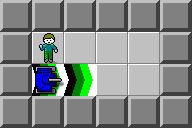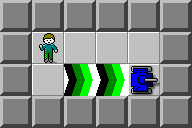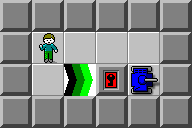Please create an account or Login! Have fun!
Multiple Tank Glitch: Difference between revisions
Tylersontag (talk | contribs) m (Tylersontag moved page multiple Tank Glitch to Multiple Tank Glitch over redirect: revert) |
(→Tile morphing algorithm: Added a diagram of tile groups for the glitch) |
||
| Line 31: | Line 31: | ||
In the second example, the west force floor is the first tile in the group [[Force floor|Force floor W]], [[Exit]], [[Blue lock]], [[Red lock]]. As [[Red lock]] is the tile that is designated "east" in this group, this is what the west force floor turns into as it slides east. By extension, one can expect that if the second example were flipped so that the west force floor now slides west, it will turn into an exit (which is the "west" tile of its group), and this is indeed what happens. | In the second example, the west force floor is the first tile in the group [[Force floor|Force floor W]], [[Exit]], [[Blue lock]], [[Red lock]]. As [[Red lock]] is the tile that is designated "east" in this group, this is what the west force floor turns into as it slides east. By extension, one can expect that if the second example were flipped so that the west force floor now slides west, it will turn into an exit (which is the "west" tile of its group), and this is indeed what happens. | ||
[[File:MTG Tile Groups.png]] | |||
This diagram shows many possible tiles that can be created using the glitch. Each group of 4 tiles is outlined in a unique color, where the topmost tile in the section would be the "north" tile, followed by "west", "south", and "east". Using this diagram one can predict that if the tank starts on a [[Ice|SW Ice Corner]] and moves south, the ice corner will turn into a fake blue wall. | |||
==Levels that use the glitch== | ==Levels that use the glitch== | ||
Revision as of 01:38, 10 April 2019
The Multiple Tank Glitch, also known as Multi Tank Bug, is a glitch caused by adding a tank to the monster list multiple times.
For other monsters that are added to the monster list multiple times, the square simply spawns more the number of monsters equal to the number of instances in the monster list. This is not true of tanks, which only spawn once no matter how many times it is added to the monster list—except in a few special circumstances. These special cases can achieve very bizarre effects in a level designed with this glitch.
This glitch occurs only in Microsoft's version of Chip's Challenge; it is not emulated by Tile World and does not exist in other rulesets.
Sliding tiles
If the tank has a sliding tile buried underneath it, then a curious effect will be observed if the tank slides on its first move. After the tank leaves the sliding tile, the tile buried underneath the tank will follow the tank and possibly morph itself into a different tile in the process. The exact tile that it morphs into is determined by an algorithm in Chip's Challenge, which is described in more detail in a later section.
For example, consider the starting configuration below, where the tank appears twice in the monster list:
After two ticks, the resulting configuration will be:
Notice how the first force floor appears to have slid two spaces to the right. Suppose instead that the tile under the tank was a west force floor instead of an east force floor. Then the ending configuration would be:
The reason the west force floor now turns into a red lock will be made clearer in the next section.
Tile morphing algorithm
What happens in the above examples is that the force floor actually behaves exactly likes a monster for one turn.
Recall that there are four copies of each monster in the tile set, one for each direction. This is important to distinguish the direction in which a monster such as a glider is moving. In order to determine which index tile to choose, Chip's Challenge groups all the monster tiles into sets of 4 consecutive tiles. Within each group, the order of tiles in the set is north, west, south, east. In addition, the first tile in each group has an index that is a multiple of 4.
In this glitch, tiles that are not normally monsters are also grouped as such since they behave as monsters for one turn. In the first example, the tiles Clone block S, Clone block E, Force floor N, Force floor E are grouped together as one monster unit (although in reality, this grouping does not make any sense since these are not monsters). Note that Force floor E is designated as the "east" tile in this group, since it is the last tile in the group. This is why the east force floor happens to remain unchanged while it slides east.
In the second example, the west force floor is the first tile in the group Force floor W, Exit, Blue lock, Red lock. As Red lock is the tile that is designated "east" in this group, this is what the west force floor turns into as it slides east. By extension, one can expect that if the second example were flipped so that the west force floor now slides west, it will turn into an exit (which is the "west" tile of its group), and this is indeed what happens.
This diagram shows many possible tiles that can be created using the glitch. Each group of 4 tiles is outlined in a unique color, where the topmost tile in the section would be the "north" tile, followed by "west", "south", and "east". Using this diagram one can predict that if the tank starts on a SW Ice Corner and moves south, the ice corner will turn into a fake blue wall.
Levels that use the glitch
- Evan Dummit: inanity.dat - (most of the levels in the set)
- ChipHome5: ChipHomeIS.dat - (most of the levels in the set)
- Tyler Sontag: TCCLPRejects.dat - Four for the Price of One



